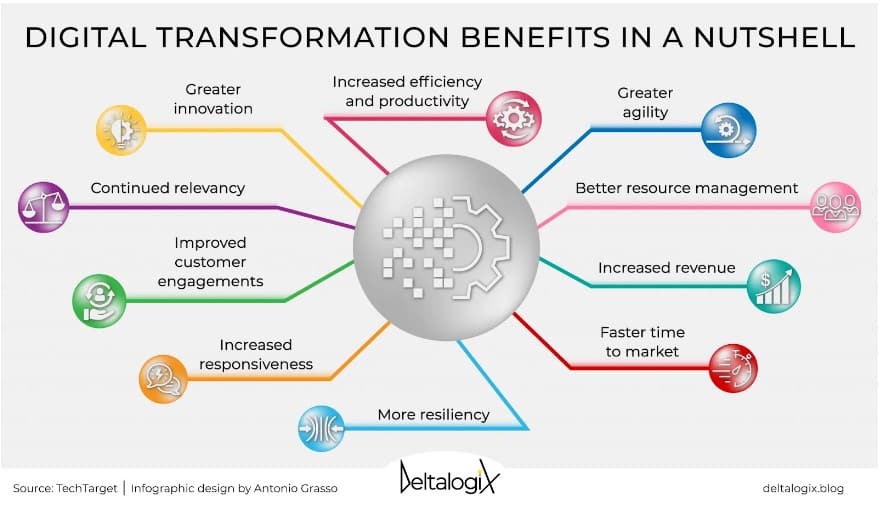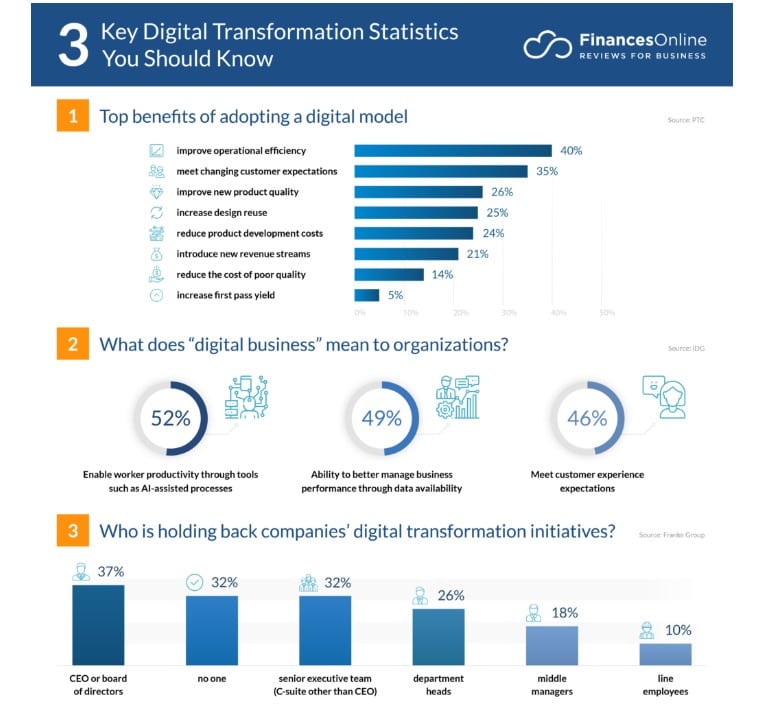Much like our daily lives, the business world has been undergoing a digital transformation. With its heavy reliance on communication, few areas of business activity rely more on digital innovation than PR.
Today, we’re inundated with new tools aimed at improving everything from client relationships to project management. Plus, the evolution of AI poses new possibilities as well as risks.
So, how do you ensure your PR firm successfully leverages technology? How can you make the most of new tools to accelerate impact for your business and clients?
In short, a digital transformation roadmap should be a key element of your PR strategy.
With careful planning, you can get ahead of the game. So, let’s drill down into what we mean by digital transformation and explore the steps to building a roadmap.
Digital transformation in focus
Before we look at a digital transformation roadmap in more detail, let’s discuss the bigger picture.
Digital transformation means updating your business activities by adopting new technology, digital tools, and practices. In a PR sense, these can affect every aspect of operations, from producing more engaging content to gaining insight into your communications strategy.
But it’s not about jettisoning every non-digital element of your business. You’ll be glad to know you don’t have to give your brand logo an all-singing, all-dancing virtual makeover. It’s more about optimizing operations to give your business a fighting chance of future success in today’s digital-first world.

Image Sourced from Deltalogix
What is a digital transformation roadmap, and why do you need one?
A digital transformation roadmap is a visualization of where you are, where you want to be, and the necessary steps to achieve that end. It should include time frames for hitting specific goals and outline why these actions are important.
Roadmaps provide clarity. So, rather than a vague aim to “‘embrace digital technology,” you set out precisely what that will look like and when and how you will do it.
On top of this, the roadmap should help team members feel included in decision making and confident that the company is invested in the future. It’s the basis of a shared vision and journey, something everyone can understand and work towards.
8 ways to create a digital transformation roadmap
Various businesses in various industries are adopting a digital model. But as you build a digital transformation roadmap, it’s crucial to consider the nuances of doing so for a PR firm. Let’s explore the key steps.
1. Identify your starting point
Look around. Get a clear picture of where you are to establish your business objectives and set an informed business strategy.
Identify the areas where digitization is needed. Ask yourself and your team:
- What are the strengths and weaknesses of your PR activities in terms of digital practices?
- Are there any areas where you can automate processes, such as sourcing media contacts or transcribing webinars?
- Can you identify any blind spots? Perhaps you have already digitized some aspects of operations but neglected others. For example, could you streamline communication channels to support client relationships?
- Is your PR firm truly embracing digitalization? Are you leveraging the power of social media and influencer partnerships or are you still relying on traditional press releases to reach your target audience?
Taking time to answer these questions will give you a clear inventory of your current capabilities and where you can improve.
2. Establish clear objectives
Next, identify where you want to go in terms of your strategic goals. These might be very specific, such as to find brand advocates on social media. But, equally, your destination could be a broader goal, such as improving productivity so you can manage more client campaigns at one time.
Whatever the destination, have as clear a vision as possible, guided by your company values and vision.
3. Get your team on board
The success of your digital transformation plan requires your entire team—your fellow journeymen and women—to understand and be on board with your digital transformation roadmap. Team members who are on board with your plan to digitally transform the firm are more likely to play an active and productive role.
Assess your ENPS, which measures how engaged and satisfied your employees are, as the success of your roadmap relies on their active participation. On top of this, make sure you share information regularly, ask for and take on board feedback, and encourage team members to make suggestions and contribute ideas.

Image Sourced from FinancesOnline
Don’t forget about senior management. Research shows that CEOs and senior team members are the biggest threat to a company’s digital transformation initiatives. So you need to ensure they’re on board.
As well as involving them in the creation of your roadmap, present them with its concrete benefits. For example, you might outline the financial benefits of digital transformation to the business in terms of ROI.
4. Assign roles
It’s important to choose which team members are best equipped to carry out the stages of your roadmap. A reshuffle in terms of who does what could breathe life into your team and ensure new ideas and fresh energy. Remember, a digital transformation is likely to affect everyone, whether they’re a senior account manager, content creator, or media coordinator.
Think outside the box. Staff members can get pigeon-holed in certain roles, so it’s worth shaking things up.
Equally, there may be team members you are used to working with. Look at proximity bias definition, and you’ll see that we can get used to working with certain people and inadvertently favor them when assigning roles.
Remember, your business model and digital transformation goals can be better served by new approaches. Giving team members new responsibilities and a chance to shine in a different role can energize a project and lead to innovation and breakthroughs. Digital transformation is about trying new approaches, so this should extend to your staffing.
5. Measure progress
PR professionals are no strangers to KPIs. We’re constantly setting them to measure the success of client campaigns.
KPIs are equally as crucial in measuring your digital transformation progress. Make sure these are specific, attainable goals. Set deadlines to help you meet these goals and check in regularly.
Deadlines help define success and measure progress. Hitting them is in part a case of setting achievable goals to begin with, but also how well your team manages their time. Investing in time management software can help everyone stay on track and use their time effectively.
Measuring progress is also a powerful tool for motivating your team and reassuring management that you are on target. A journey seems interminable without seeing how far you have come.

6. Take small but decisive steps
Whether your digital transformation is for a large enterprise or small business, breaking down the process into smaller tasks is wise.
It’s important in terms of staff motivation to lay in some quicker, smaller tasks to keep your team rewarded with a sense of accomplishment. This can be a huge morale booster and make the road ahead—and their digital journey—feel more achievable. This is especially important if your digital transformation is likely to be lengthy or even ongoing.
When designing more bite-sized tasks, concentrate on ones that can boost ROI fairly quickly, as well as those jobs that will take time to yield a return.
Breaking down the road ahead with smaller, achievable projects is a good way to measure success, as you can more quickly gauge if your financial and staffing outlay was worth it.
7. Review, review, review
Ongoing evaluations are always beneficial. Plus, a single roadmap is unlikely to be the end of your digital transformation journey as change—within your company, the wider PR industry, and the digital landscape—is inevitable.
You can learn lessons from how successful your first roadmap has been and apply insights to the next. When you evaluate your team’s contributions, give clear feedback and ask team members for their own take on how things have gone.
Go back to your original goals and check that your digital solutions are aligned with them. Thoroughly assessing the success of any project as well as the performance of stakeholders ensures better outcomes for the future.
8. Embrace change
By its very nature, digital transformation involves change, which can be both positive and challenging. Change is necessary for any business to thrive, and you need to embrace it.
This is especially important when it comes to digital initiatives. New technology and digital tools require a team to work in different ways, but also to think differently. If your team can see this change as positive and energizing, it will give the journey momentum and make it more likely to lead to success.
Change is something that has to be embraced on an ongoing basis and should be embedded in company culture. Client demands and market forces are constantly changing. To meet these challenges, digital transformation is not likely to be over and done with once you have achieved your goals. Your roadmap will likely be the first of many during the life of your business.
Conclusion
There’s no denying the modern PR landscape is shifting. People are changing the way they digest and engage with content. As a result, there are increasing opportunities and challenges for the PR professional.
To keep up and truly excel, you need to embrace all that the digital world has to offer, from social media and virtual reality campaigns that will set your clients apart to online tools that can help your team internally.
A digital transformation roadmap will help you get there. If you follow the steps we have outlined and continually monitor where you are succeeding or failing, your PR firm can only benefit.








